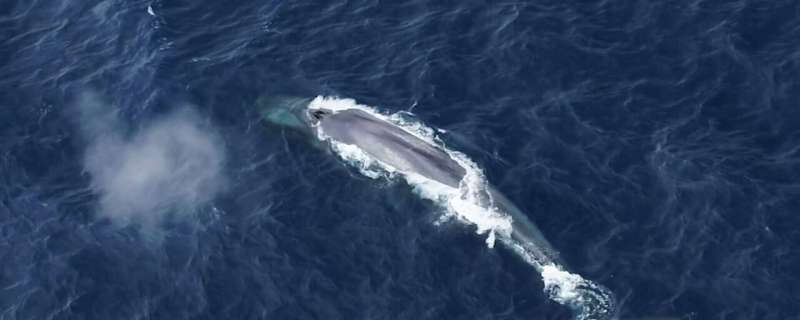This article has been reviewed according to Science X's editorial process and policies. Editors have highlighted the following attributes while ensuring the content's credibility:
fact-checked
peer-reviewed publication
proofread
Listening to giants: The search for the elusive Antarctic blue whale

Blue whales are the largest animals on Earth, measuring up to 30 meters long and weighing up to 200 tons—as much as a Boeing 787. Yet it's the sound they make, not their size, which gives their location away.
As a marine mammal acoustician, Dr. Brian Miller would know. He's spent thousands of hours listening for and tracking the elusive ocean giants.
"Antarctic blue whales are critically endangered, and this makes them difficult to find in the vast Southern Ocean, but they make very loud, low frequency calls that we can detect from hundreds of kilometers away, using acoustic technology," he said.
The marine mammal research team, from the Department of Climate Change, Energy, Environment and Water's Australian Antarctic Division, and their international colleagues, have now released a comprehensive snapshot of blue whales in Antarctica, based on acoustic data, published in Frontiers in Marine Science.
The data showed that Antarctic blue whales are distributed right around Antarctica and through the sub-Antarctic during summer.
"This analysis represents the most contemporary circumpolar information on the distribution of these rarely sighted and elusive animals, which were hunted to the brink of extinction during industrial whaling," Dr. Miller said.
"Our analysis and the collated datasets will serve as a baseline and springboard for future work."
For almost two decades the team has been using free-floating "sonobuoys" as "listening stations," to detect, track and record Antarctic blue whale and other whale sounds.
Spending more than eight months at sea, on seven voyages, the team has traveled more than 145,510 kilometers and monitored nearly 3,900 hours of sound from listening stations all around Antarctica.
In combination with other study methods, including satellite tracking, video tracking, photography, DNA sampling, drones, and artificial intelligence, they are building a picture of the distribution, abundance and behavior of the animals.
Dr. Miller said that sonobuoys are one of the most cost-effective way of studying blue whales, but there are limits to what can be learnt from listening alone.
Each sonobuoy has a hydrophone that transmits sound back to the ship in real time via a VHF radio link.
Once blue whale calls are detected, the team can get a direction to the whales and then deploy more instruments to get a precise position.
"Over the last 20 years we've really honed our ability to locate and find these animals acoustically," Dr. Miller said.
"We can reliably listen for them, sail to them and visually sight them, then photograph and follow them, and even take small biopsies of their skin and blubber for further study."
The newly published study focused on recordings of loud, low frequency "songs" that were specific to Antarctic blue whales—the "Z-call" and part of the Z-call known as "Unit-A."
The study also analyzed the non-song "D-call," which is made by all blue whale populations.
D-calls are thought to be social calls made by male and female whales on feeding grounds, while the song calls are only made by males.
"Unit-A was the most widely distributed call detected on the largest number of sonobuoys throughout the Antarctic and sub-Antarctic," Dr. Miller said.
"We detected more of the non-song D calls earlier in the summer feeding season, and the Unit A and Z song calls later in summer and early autumn."
The team said more research is needed to understand the relationship between the whales and their major food source, krill, in the face of environmental change and increasing krill fishing pressure.
This could involve a range of new study methods, including a fleet of uncrewed vehicles, equipped with hydrophones to detect the whales, and other instruments to study the whales' prey.
Scientists could also attach hydrophone accelerometry tags to whales, which record calls and measure swim speeds, to understand how the type and amount of vocalization relates to foraging rates.
"Passive acoustic monitoring is poised to play a crucial role in future research addressing knowledge gaps about Antarctic blue whales," Dr. Miller said.
More information: Brian S. Miller et al, Antarctic sonobuoy surveys for blue whales from 2006-2021 reveal contemporary distribution, changes over time, and paths to further our understanding of their distribution and biology, Frontiers in Marine Science (2024). DOI: 10.3389/fmars.2024.1324816
Journal information: Frontiers in Marine Science
Provided by Australian Antarctic Program




















